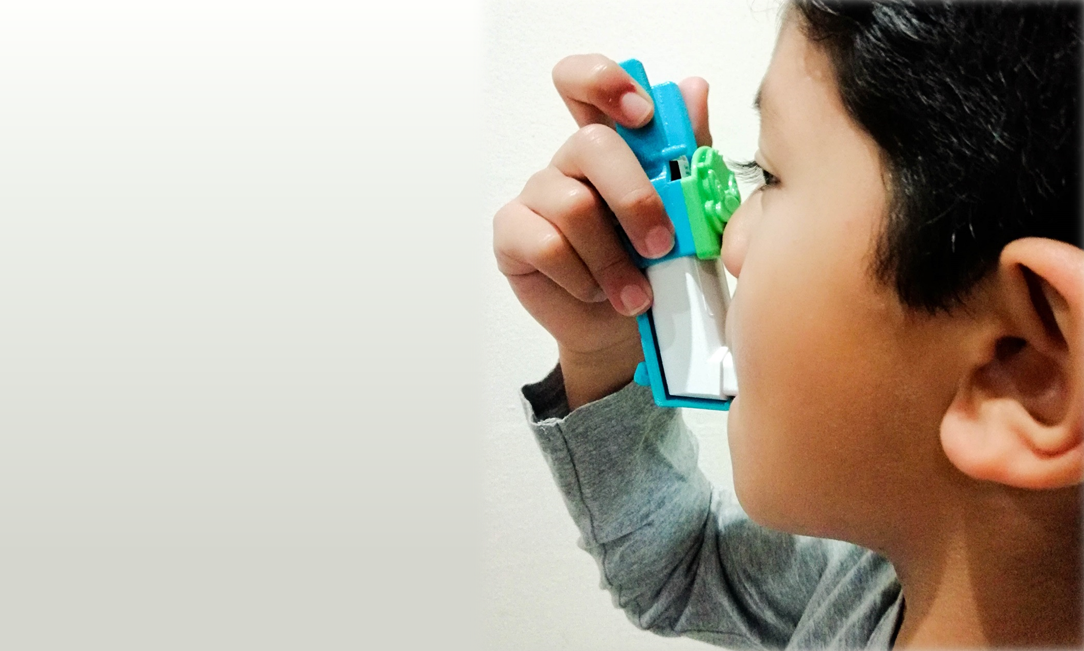An asthma device for children and the aged

A collaboration between biomedical engineers and a clinician at the University of Cape Town led to the design of an assistant device for metered-dose asthma inhalers to improve ease of use for children and the elderly.

The Easy Squeezy has been developed by a team of biomedical engineers and a clinician at the University of Cape Town to dramatically reduce the force required to activate metered-dose asthma pumps.
A new device – aptly named the Easy Squeezy and developed by biomedical engineers and a clinician at the University of Cape Town (UCT) – dramatically reduces the force required to activate an asthma pump. It also aims to minimise the stigma associated with using pumps by adding decorative cartoon characters for young patients.
Statistics show that in South Africa about 10% of adults and 20% of children suffer from asthma, and the country has the fourth highest asthma-related death toll. Since they are relatively affordable and widely available, metered-dose inhalers are most commonly prescribed to those who suffer from this life-threatening respiratory condition.
These devices are, however, not ideal for patients with reduced muscle strength, as the force required to administer the medication outweighs their capabilities. This is especially problematic for young children and the elderly, and could compromise the delivery of their medication.
As head of the Division of Asthma and Allergy at the Red Cross Children’s Hospital in Cape Town, Dr Michael Levin is all too familiar with this challenge.
“We spend a lot of our time counselling patients about the importance of using their pumps every day with the best possible technique. And often we place blame on them when they don’t use them every day.
“But what if they are trying, but just can’t manage to get it right?” he asks.
Watching his patients, including his own daughter, having difficulty using their pumps inspired the thought: what if we could make a way of pressing the pumps easier?
Collaboration with the University of Cape Town
Levin then approached Professor Sudesh Sivarasu, head of the Medical Devices Lab in UCT’s Department of Biomedical Engineering, with his idea.
Sivarasu was the ideal partner for the project, as his trademarked concept of Frugal Biodesign aims to understand innovation in the context of resource-restricted environments, local conditions and the needs of the appropriate ‘user’ – that is, the clinician.
“It is essential to have the clinician on board from the start to the end of the innovation cycle, Sivarasu explains. “Unlike in the past, where clinicians proposed a problem and only came back a year later to see how the design had progressed, Frugal Biodesign eliminates failures from the beginning through close collaboration.”
He identified two of his master’s students – Giancarlo Beukes and Gokul Nair – to take on the project. Sharing a passion for designing medical devices that have the potential to save lives, Beukes and Nair had just launched a UCT spinout company, Impulse Biomedical, with the assistance and guidance of UCT Research Contracts and Innovation.
Addressing three common problems
Beukes and Nair were tasked with solving three design challenges common to most metered-dose inhalers: the force required to activate the pump, an adjustable dosage counter and the stigma attached to using these scary-looking devices, especially among children.
Instead of trying to introduce a whole new asthma pump design, they decided to develop a sleeve that is easily slipped over a regular metered-dose inhaler. With its ‘bunny-ear’ design, the assistant device allows children and elderly patients to activate the pump easily using their whole hand to pinch, instead of struggling with two or three fingers, as is the norm.
“This effectively reduces the force from four kilograms down to 1.25 kilograms. Now, based on our calculations, children five years and older can activate their standard asthma pump whereas previously only children 12 years and older could,” Beukes explains.
The dosage counter problem was solved by designing a ratchet-type system, activated by the inner translation of the ‘bunny ears’. Reminiscent of a pie chart, the ratchet gear is mostly green, with a small slice of red.
“Green is safe. Red, indicates that it’s time to change the inhaler,” Beukes explains.
Once these two more technical challenges had been addressed, it was time to tackle stigma.
“Stats show that 42% of kids don’t want to carry their device with them, because it’s rather scary-looking and they’re worried about being bullied,” Nair says. “So, we’ve added cartoon characters to each of the devices that can be swopped out according to the child’s taste. This just makes it more fun and interesting.”
Future plans
Through the collaboration between Levin, Sivarasu, Beukes and Nair, the Easy Squeezy design has reached proof of concept and is being refined. The next step is to conduct a trial that validates use of the device. While the ideal is eventually to have the device commercialised and freely available in pharmacies for roughly ZAR120 each (about USD8.5), it will take some patience before they reach this point.
Impulse Biomedical and RC&I are currently raising funds to continue the development and commercialisation of the technology. They are also inviting collaboration with aligned pharmaceutical companies, such as those selling metered-dose inhalers, to bring this innovation to market.
“As a start-up, you need to take baby steps. So, the first one would be access to patients,” explains Beukes. Fortunately, working closely with Levin and the team at RC&I will make this relatively easy.
“We’d like to first do market research at Red Cross Children’s hospital, get feedback from Mike’s patients and see how they feel about the device, which characters they prefer and grow it from there.”
Story: Nadia Krige. Photo: University of Cape Town.